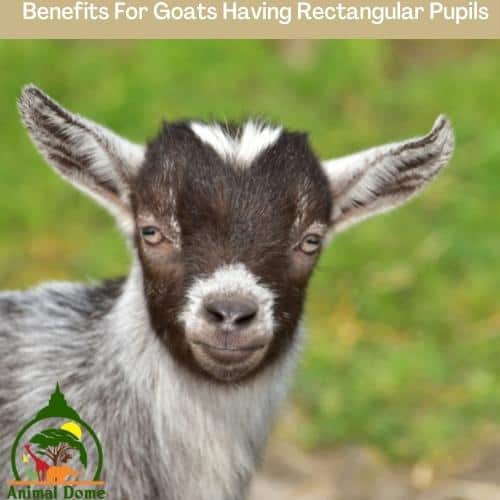A goat’s gaze might even be downright unsettling to some people. This is because the goats’ pupils are horizontal rather than circular or vertical, like ours or a cat’s.
Why do goats have rectangular pupils? Because they are herbivores, goats need to be able to defend themselves if a predator approaches. They have a wide field of vision and wide, rectangular-shaped pupils that help them see approaching danger.
According to researchers at the University of California, Berkeley, the position of goats in the food chain can be inferred from the shape of their pupils.
According to Martin Banks, the principal investigator of the University of California study, their eyes also possess the remarkable capacity to “rotate in the head to maintain parallelism with the ground.” As a result, when grazing, goats’ heads are bowed down so that their eyes are level with the horizon, giving them a better view of approaching danger.
One of the many characteristics that set goats apart—and, in our opinion, a reason to cherish and safeguard them even more—is their horizontal pupils.
Goat Eyes vs Human Eyes
The Capra aegagrus hircus eye will probably go unnoticed by the majority of people, but if it is noticed, it is rather fascinating. The goat’s eye pupils are rectangular, as opposed to ours, which are round, and this explains why.
Goats can spot a predator coming from a wide range of directions thanks to their wide field of vision and rectangular-shaped pupils. Capra aegagrus hircus is a distinct species due in large part to its rectangular pupils. Because vertical side-slanted eyes aid in providing significantly wider vision, goats have rectangular or horizontal eyes.
The goats can regulate how many light rays penetrate their eyes because of the structure of their pupils. For clear eyesight, the eyes of all grazing animals are vertically inclined.
Did you know that goats’ and humans’ pupils differ from one another? Examine how a goat’s and human’s eyes vary from one another.
Goats’ irises are discovered to be whiter than human eyes. Humans are unable to perceive 320 degrees, but goats can. Like cuttlefish or squid, goats have peculiar pupils in their eyes.
The goats’ eerily alien-like pupils have a 360-degree field of vision with no frontal spot. Goats’ eyes have exceptionally good, complete vision thanks to this Prezi. It keeps any obstructions out of the way.
Although different animals have different kinds of pupils, the majority of them have some traits. The human eye does not employ film; instead, it directs light toward the retina, a membrane that is sensitive to light.
However, in humans, a sensitive membrane called the retina receives light. The area between the iris and the cornea is filled with a clear liquid called aqueous humor. A crystalline lens, which is clear and colorless, is located behind the pupil of the human eye. The iris, retina, lens, and other components of the human eye are made up of 30 pieces.
Benefits For Goats Having Rectangular Pupils

One of the primary tactics used by animals to defend themselves is using their line of sight, so goats must be able to do the same. Their eyes are positioned on the sides of their heads for the best possible peripheral vision, and they have huge, rectangular pupils that provide them with even greater vision.
This characteristic is seen in many different kinds of wild prey. Prey animals generally have their eyes on the sides of their heads, but predators typically have their eyes closer forward during a hunt. Naturally, this rule has a lot of exceptions.
In addition to making spotting predators much simpler, their rectangular pupils are believed to provide a complete 360-degree view of their environment.
Goats have great night vision because of their long, rectangular pupils, which also allow more light to reach the retina. Night vision is crucial because predators frequently prefer to hunt their victims while it is dark. Additionally, goats have a broad range of color perceptions.
They are not color blind, and they can tell orange from other hues the best. They can more easily spot predators that are hiding in the foliage because of this.
Additionally, it’s fascinating to note that goats adjust their heads to keep their eyes level with the ground by rotating their eyeballs. As they drop their necks to graze, this enables them to remain constantly aware of their surroundings. Modern domestic goats, as well as wild goats, nonetheless struggle to flee from predators.
Don’t assume that your goat’s exceptional night and peripheral vision will be sufficient to keep it safe from predators. Goats are herd animals that rely on group protection and warning one another of danger. Therefore, warning of danger is not only provided by having excellent peripheral vision but also by having many people present.
No matter how large or tiny, what color their eyes are, or whose breed they are, all goats have rectangular pupils.
What Colors Do Goats See?
Goats often perceive colors in a spectrum that is comparable to ours but not quite as vivid or powerful. They cannot detect red or green, but they can perceive blue and yellow colors quite clearly. Goats only have two cone Opsin proteins, a Short Wavelength Sensitive Cone, indicating that they have dichromatic vision (SWS or S-cone).
The best color a goat can see depends on how many cones it has. For instance, because red and green both seem yellow to goats with only two cone kinds, they are unable to discriminate between the two hues.
They benefit from this since they spend most of their time in low-lying open grasslands where it is frequently too bright during the day and too dark at night. Additionally, it improves their peripheral vision so they can keep an eye out for predators like coyotes, bobcats, and mountain lions who follow their prey before suddenly striking from behind.
Are Goats the Only Animals With Rectangular Pupils?
Although they are extremely uncommon, rectangular pupils are not just found in goats. Equine and ruminant species are the two primary animal species with this kind of eye. For a variety of reasons, this characteristic is shared by sheep, deer, and horses.
Octopuses, on the other end of the animal spectrum, also have rectangular pupils that resemble goats in appearance. Once more, this controls light entering the retina and shields it from glare during the day.
Some toad species also have recognizable rectangular pupils that help shield them from glare and excessive light exposure. Although goats are not the only species with rectangular pupils, they are also not particularly frequent. How they are shared by animals as different as goats and octopuses is quite intriguing. All of these animals have long, narrow pupils that allow them to control the amount of light entering their eyes, avoid being dazzled, and yet see quite well at night.





